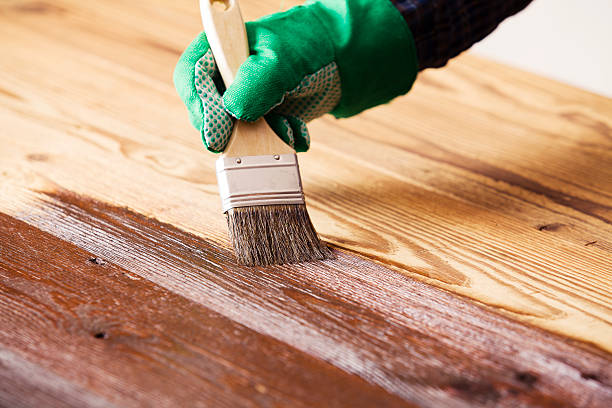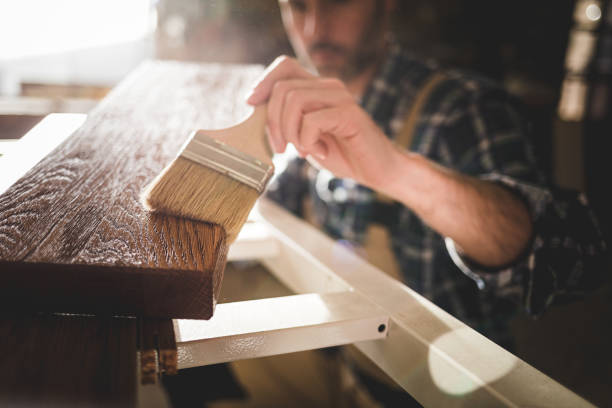You’re standing in your yard, looking at weathered wood siding, and wondering whether you should paint or stain. The paint vs stain wood fence debate has been keeping you up at night, and you’re not alone. Every year, thousands of homeowners face this same decision about their exterior wood surfaces. The choice between paint vs stain exterior wood isn’t just about looks—it affects your home’s protection, maintenance schedule, and long-term costs for the next decade.
The Real Difference Between Paint vs. Stain
When comparing paint vs stain exterior wood, the fundamental difference lies in how each product interacts with your wood surfaces. Paint creates a protective film that sits on top of the wood, forming a barrier against moisture, UV rays, and insects. Stain, on the other hand, soaks into the wood fibers, protecting from within while allowing the natural grain to show through.
This difference affects everything from application to maintenance. Paint requires a clean, smooth surface and multiple coats to build that protective barrier. Stain needs wood that can absorb it, which means different prep work and application techniques.
In Bellbrook, OH, we see both approaches work well depending on the specific application and homeowner preferences. The key is matching the right product to your wood type, climate exposure, and maintenance preferences.
How Long Does Each Option Actually Last?
The lifespan question drives most paint vs stain exterior wood decisions, and the answer isn’t simple. High-quality exterior paints like Benjamin Moore Aura Exterior or Sherwin-Williams Duration can protect wood siding for 10-15 years when properly applied over quality primer.
Stain longevity depends on the type you choose:
- Transparent stains: 2-3 years
- Semi-transparent stains: 4-5 years
- Solid color stains: 6-7 years
These numbers assume proper application and average weather exposure. In our experience serving Bellbrook homeowners, decks and fences often need stain refreshing every 3-4 years due to direct weather exposure, while protected siding can stretch longer between coats.
The catch with paint durability is maintenance complexity. When that 10-15 year mark hits, you’re looking at scraping, sanding, caulking, priming, and applying two fresh coats. Stain maintenance typically involves cleaning and applying one new coat.
Maintenance: The Hidden Cost Factor
Here’s what paint companies won’t tell you upfront: paint vs stain exterior wood maintenance requirements are drastically different. Paint maintenance is intensive but infrequent. Stain maintenance is lighter but more frequent.
Paint Maintenance Process:
- Scrape loose or peeling paint
- Sand rough areas smooth
- Fill cracks and holes with exterior caulk
- Prime bare wood and repairs
- Apply two coats of quality exterior paint
Stain Maintenance Process:
- Power wash the surface
- Apply wood brightener if needed
- Let dry completely
- Apply one coat of matching stain
The labor difference is significant. Paint refresh projects often take 3-4 days for an average home exterior. Stain refresh can usually be completed in 1-2 days.
From a cost perspective over 20 years, paint often wins despite higher upfront costs. But if you prefer spreading costs over time with easier maintenance, stain makes sense.
Climate Impact: Why Location Matters for Paint vs Stain Exterior Wood
Your local climate plays a huge role in paint vs stain exterior wood performance. Paint excels in hot, dry climates where its UV resistance shines. However, in humid areas like Ohio, paint can peel if moisture gets trapped behind the film.
Stain allows wood to breathe, releasing moisture naturally. This makes it superior in regions with:
- High humidity
- Frequent rain
- Freeze-thaw cycles
- Coastal salt exposure
For Bellbrook homeowners, our climate falls into that humid category where stain often outperforms paint on horizontal surfaces like decks and fences. Vertical siding handles moisture differently, so paint remains viable there.
The worst-case scenario is paint failure in humid climates. When the film cracks and water gets behind it, you’re looking at potential wood rot and expensive repairs beyond just repainting.
Cost Analysis: Upfront vs Long-Term
The paint vs stain exterior wood cost question has multiple layers. Here’s what the real numbers look like:
Upfront Material Costs (per gallon):
- Quality exterior paint: $45-65
- Primer: $35-45
- Quality exterior stain: $40-55
Labor Hours (typical 2,000 sq ft home):
- Paint application: 32-40 hours
- Stain application: 24-30 hours
20-Year Cost Projection:
- Paint: Initial cost + one major refresh = roughly 1.5x initial investment
- Stain: Initial cost + 4-5 refresh cycles = roughly 3x initial investment
These numbers assume professional application. DIY can reduce labor costs but rarely achieves the same longevity as professional work.
Many homeowners choose stain because the upfront cost feels more manageable, but the math favors paint for long-term homeowners. If you’re planning to sell within 5-7 years, stain’s lower initial cost might make more sense.
Appearance Options: Unlimited Colors vs Natural Beauty
Paint wins hands-down for color flexibility. Any color you can imagine is possible with paint, and you can completely hide wood imperfections, knots, and grain patterns. This makes paint the go-to choice for modern, uniform appearances.
Stain celebrates wood’s natural character. Even solid color stains maintain some texture and grain visibility that paint completely covers. For cedar siding, redwood decks, or rustic fences, stain enhances rather than hides the wood’s inherent beauty.
The aesthetic choice often reflects personal style and home architecture. Traditional homes often look better with paint’s clean lines, while rustic or contemporary designs might benefit from stain’s organic appearance.
Color trends also affect this decision. Paint allows you to update your home’s look completely with each refresh. Stain limits you to colors that work with your wood’s natural tones.
Which Surfaces Work Best with Each Option?
Not all exterior wood surfaces are equal in the paint vs stain exterior wood debate. Here’s what works best where:
Paint Performs Best On:
- Vertical wood siding
- Trim and shutters
- Front doors and accent pieces
- Previously painted surfaces
- Wood with imperfections to hide
Stain Performs Best On:
- Decks and deck railings
- Fences (especially horizontal surfaces)
- Cedar or redwood siding
- Pergolas and outdoor structures
- Wood with beautiful natural grain
The pattern here is exposure and surface orientation. Horizontal surfaces that take direct weather exposure often perform better with stain because it penetrates and allows moisture to escape. Vertical surfaces with good drainage can handle paint’s barrier approach successfully.
Mixed approaches work too. Many Bellbrook homes have painted siding with stained decks and fences. This gives you paint’s longevity where it works best and stain’s easy maintenance where you need it.
Common Mistakes That Ruin Paint vs Stain Exterior Wood Projects
After years of fixing failed coating jobs, we see the same mistakes repeatedly:
Paint Failures:
- Skipping primer on bare wood
- Painting over moisture or dirt
- Using interior paint outdoors
- Applying paint in direct sunlight
- Not caulking gaps before painting
Stain Failures:
- Staining wet or dirty wood
- Over-applying stain (it won’t penetrate)
- Using stain on previously painted surfaces
- Ignoring manufacturer’s temperature guidelines
- Skipping wood prep completely
The biggest mistake is rushing the prep work. Both paint and stain need clean, properly prepared surfaces to perform as designed. Cutting corners on preparation almost always leads to premature failure.
Red Flags: When to Avoid Paint or Stain
Some situations make the paint vs stain exterior wood choice obvious by elimination:
Don’t Use Paint When:
- Wood moves significantly (like deck boards)
- Moisture regularly penetrates the surface
- You want to see natural wood grain
- The previous coating was stain
Don’t Use Stain When:
- Wood is already painted
- You need dramatic color change
- The wood has been pressure treated recently
- You want maximum UV protection
Trying to stain over paint never works because stain can’t penetrate the paint film. Similarly, painting over stain requires careful surface preparation to ensure adhesion.
Making the Final Decision: Paint vs Stain Exterior Wood
Your paint vs stain exterior wood decision should weigh these factors in order of importance for your situation:
- Maintenance preference: Do you want less frequent, intensive maintenance (paint) or more frequent, easier maintenance (stain)?
- Longevity plans: Staying 10+ years favors paint; selling sooner might favor stain’s lower upfront cost.
- Climate exposure: Humid conditions often favor stain; dry climates favor paint.
- Aesthetic goals: Uniform, unlimited colors point to paint; natural wood beauty suggests stain.
- Surface type: Horizontal surfaces lean toward stain; vertical surfaces can go either way.
Most homeowners find that a mixed approach works best—paint for siding and trim, stain for decks and fences. This maximizes each product’s strengths while minimizing weaknesses.
What Professional Painters Won’t Tell You
Here’s insider knowledge from years of exterior coating projects: the brand matters less than proper application. A mid-grade paint or stain applied correctly will outperform premium products applied poorly.
Professional crews also know that wood condition affects performance more than product choice. Dry, weathered wood absorbs stain unevenly. Painted wood with moisture issues will fail regardless of paint quality.
The most successful paint vs stain exterior wood projects start with honest wood assessment. Sometimes that means replacing boards, treating problem areas, or even switching coating types based on what’s actually happening with your specific wood surfaces.
Want to see how professional crews handle these challenges? Check out this behind-the-scenes look at a typical exterior coating project.
Questions Homeowners Ask About Paint vs Stain Exterior Wood
Can you paint over stained wood? Yes, but it requires proper preparation. The stain must be completely cleaned, and you’ll need a high-quality primer designed to bond over stain. Skip this step and the paint will peel.
Which is more environmentally friendly? Water-based products (both paint and stain) have lower VOC emissions than oil-based versions. Many manufacturers now offer low-VOC or zero-VOC options that perform well.
How do I know if my wood is ready for coating? Sprinkle water on the surface. If it soaks in quickly, the wood can accept stain. If water beads up, you need to clean or sand before any coating application.
What happens if I use interior products outside? Interior products aren’t formulated for UV exposure and temperature swings. They’ll fail quickly outdoors, often within one season.
Should I hire the same company for paint and stain work? Most professional painting companies handle both products competently. The key is finding contractors experienced with your specific wood type and local climate conditions.
Your Next Steps
The paint vs stain exterior wood decision affects your home’s protection and appearance for years to come. Take time to evaluate your specific situation—wood condition, climate exposure, maintenance preferences, and long-term plans.
Both paint and stain can protect your exterior wood successfully when matched to the right application and applied professionally. The worst choice is delaying the decision while your wood deteriorates from weather exposure.
Our exterior house painting services include comprehensive wood preparation, premium products, and warranties that protect your investment. Whether you choose paint, stain, or a combination approach, you’ll get results that enhance your home’s beauty and protection for years to come.





